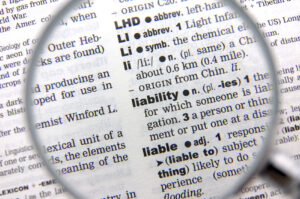Liability

Liability is the legal concept that someone is legally responsible for the harm someone else has suffered. If someone is liable for your injuries, they are responsible for paying for the damages you’ve suffered. Keep reading to learn about the role that liability can play in your personal injury case.
Legal Theories of Liability

Liability can be established under several legal theories:
- Intentional Torts: When someone deliberately causes harm, they can be held accountable for the victim’s injuries.
- Strict Liability: In certain cases, such as those involving defective products or hazardous activities, a party may be held responsible regardless of intent or negligence.
- Negligence: This is the most common basis for personal injury claims. Negligence occurs when someone fails to exercise reasonable care, leading to another person’s injury.
To succeed in a negligence-based claim, four legal elements must be proven:
Duty of Care
Duty of care is the legal duty that someone owes to another. For example, motorists have a duty to follow the instructions in the driver’s manual to avoid collisions with other motorists. Property owners have a legal duty to maintain their property to prevent visitors from sustaining injuries. Medical providers must follow the standard of care that other healthcare providers with similar training and backgrounds would exercise under similar circumstances.
Breach of Duty
A breach of duty is any act or omission that violates the duty of care. For example, a motorist might violate their duty of care by speeding, driving distractedly, or drinking and driving, resulting in a car accident. Alternatively, a property owner may have failed to post warning signs or address a known problem on their property that led to a slip and fall accident.
Causation
Causation links the act or omission to the injury. To recover compensation, you must be able to prove that the accident would not have occurred but for the act or omission. Additionally, the accident must have been a foreseeable consequence of the defendant’s actions.
Damages
Damages are the losses you sustained as a result of the accident, such as:
- Medical expenses
- Lost wages
- Reduced earning capacity
- Car repairs
- Pain and suffering
- Mental distress
Receipts and other documentation can help establish the value of these damages.
How to Prove Liability
As the plaintiff in a personal injury case, you have the burden of proof. In civil cases, the burden of proof is by the preponderance of the evidence, meaning that the facts are more likely than not as you allege. This burden of proof applies to each legal element.
Evidence that can help prove fault and causation includes:
- Dash camera footage
- Contracts
- Communications between you and the defendant
- Accident reports
- Photos of the accident scene
- Employment records
- Digital records
- Toxicology reports
- The defendant’s admissions
- Social media statements
Damages can be proven with evidence, such as:
- Receipts
- Medical bills
- Check stubs
- Employment records
- Expert assessments
- Pain journals or daily logs of physical and emotional symptoms
An experienced personal injury attorney can help identify evidence to establish your legal claim.
How Shared Fault Affects Compensation in Kentucky
In Kentucky, if you’re injured in an accident but are partially at fault, that doesn’t mean you’re barred from seeking compensation. The state uses what’s called a pure comparative fault rule. This means that if you were partly responsible, your financial recovery will be reduced by whatever percentage of the blame you’re assigned.
Say a jury decides your damages total $80,000, but also finds you were 25% at fault. In that case, you could still receive $60,000. This rule allows injured people to recover something, even when they weren’t entirely blameless, but it also gives the other side an incentive to push more blame on you than you deserve.
To minimize your liability, having a lawyer who can present strong evidence and clear arguments can make a big difference in your outcome.
Time Limits for Filing a Personal Injury Lawsuit in Kentucky
Kentucky has some of the strictest deadlines in the country when it comes to filing personal injury lawsuits. In most cases, you only have one year from the date of your injury to take legal action. That window can close quickly, and once it does, you likely won’t be able to pursue compensation, no matter how serious your injuries are.
There are some exceptions. If your injury was the result of a car accident, you might have up to two years from the date of the accident. Because missing the applicable deadline usually means losing your chance at recovery, it’s important to talk to an attorney soon after the accident.
Contact an Experienced Louisville Personal Injury Lawyer Today for a Free Consultation
If you were injured in an accident, HJV Car Accident Personal Injury Lawyers can help. We can carefully investigate your accident, identify the potentially liable parties, and gather the necessary evidence to support your claim.
Contact us today or call at (502) 540 5700 to arrange your free consultation with a Louisville personal injury attorney.